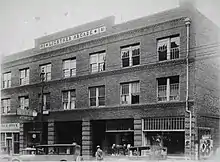Calvin E. Lightner
Calvin Esau Lightner (1877 – May 21, 1960) was an American architect, building contractor, and mortician.
Early life
Calvin Lightner was born in 1877 in Winnsboro, South Carolina, United States, to Frank and Daphney Lightner, a carpenter and a homemaker.[1] He moved to Raleigh, North Carolina in 1898 and enrolled at Shaw University, graduating in 1908.[2]
Career

In 1907 Lightner designed and built his own home in Raleigh, despite not having any formal education in construction.[3] Following his graduation from college, Lightner worked as a mortician's apprentice before establishing his own funeral home—the first such business for black people in Raleigh—despite not having an official charter to do so.[4] In 1909 he erected the Lightner Building on East Hargett Street in Raleigh, thus creating the second black-owned building on the street after the Odd Fellows Building.[5] In 1911 he received a state charter to set up a funeral business[1] and founded the Lightner Funeral Home on October 1,[6] operating it out of the first floor of the Lightner Building.[5] He subsequently oversaw the construction of many business of East Hargett Street,[7] and thus sparked a shift in the concentration of Raleigh's black-owned businesses from Wilmington Street to East Hargett,[5] which became known as the city's "Black Main Street."[7]
Lightner was a member of the National Association for the Advancement of Colored People. In 1919 he and two other black men, Laurence Cheek and Manassa Thomas Pope ran for municipal offices in Raleigh; Lightner sought the post of Commissioner of Public Works.[8] Jim Crow restrictions prevented most black men from voting and all three lost their elections.[7] Lightner earned 142 votes, the most of any of the black candidates.[9] Reflecting on the campaign, he said "Even if we had won we knew the whites wouldn't let us administer. But we just wanted to wake our people up politically."[7] The campaign garnered the support of many blacks and provoked the ire of some white leaders, who as a result discouraged other white people from supporting black enterprises.[10]
In 1921 Lightner built the Lightner Arcade and Hotel across the street from the Lightner Building, later joking that he decided to erect it after his wife had complained that he hosted too many friends from out of town at their home.[5] The arcade quickly became a center of social activity for Raleigh's black community, and was considered one of the best hotels for black clientele along the East Coast of the United States.[11] During its existence it was the only hotel in Raleigh that would accept black customers and hosted musicians Cab Calloway, Count Basie, and Duke Ellington.[12] The building also housed a restaurant, drug store, barbershop, and the offices of The Carolinian.[11] Lightner also heavily remodeled Davie Street Presbyterian Church in 1922,[13] where he became a parishioner,[2] and designed the Mechanics and Farmers Bank Building in Durham.[3] Following the Great Depression, Lightner sold his hotel.[5] In 1941 he purchased the Capehart House and moved his funeral home there.[14] In 1959 he gave control of his funeral home to his son, Clarence.[10]
Later life
Lightner died on May 21, 1960 at St. Agnes Hospital in Raleigh. A funeral was held for him on May 25 at Davie Street Presbyterian Church, and he was buried in Mt. Hope Cemetery.[2] The Lightner Arcade burned down in 1968.[5] Lightner's son, Clarence, was elected Mayor of Raleigh in 1973.[15]
References
- Bunch-Lyons 2015, p. 62.
- "C. E. Lightner, Builder And Mortician Is Buried". The Carolinian. 19 (33). May 28, 1960. pp. 1–2.
- "Pioneering Black Architects in North Carolina". NCModernist. Retrieved June 14, 2020.
- Bunch-Lyons 2015, pp. 61–62.
- Mills, Beverly (February 28, 1982). "East Hargett Street was center of black life and business". The News & Observer. Retrieved June 13, 2020.
- "Lightner Funeral Home Operates Modern Business". The Carolina Times. 21 (32). August 10, 1940. p. 7.
- Woltz, Rebecca (February 26, 2020). "Off the beaten path: Pope House Museum". The Warren Record. Retrieved June 13, 2020.
- Zogry 2008, pp. 206–208.
- Zogry 2008, p. 213.
- Bunch-Lyons 2015, p. 64.
- Kulikowski & Peters 2002, p. 52.
- Christensen, Rob (November 10, 2017). "When Raleigh elected a black mayor". The News & Observer. Retrieved June 13, 2020.
- East Raleigh-South Park Historic District 1990, section 7, page 12.
- East Raleigh-South Park Historic District 1990, section 7, page 112.
- Zogry 2008, p. 7.
Works cited
- Bunch-Lyons, Beverley. "'Ours is a Business of Loyalty': African American Funeral Home Owners in Southern Cities" (PDF). The Southern Quarterly (Fall 2015 ed.). 53 (1): 57–71. ISSN 2377-2050.
- East Raleigh-South Park Historic District (PDF), National Register of Historic Places, United States Department of the Interior, 1990
- Kulikowski, Jennifer A.; Peters, Kenneth E. (2002). Historic Raleigh. Charleston: Arcadia Publishing. ISBN 9780738514406.
- Zogry, Kenneth Joel (2008). The house that Dr. Pope built: Race, politics, memory and the early struggle for civil rights in North Carolina (PhD thesis). University of North Carolina at Chapel Hill. doi:10.17615/vp95-m724.CS1 maint: ref=harv (link)